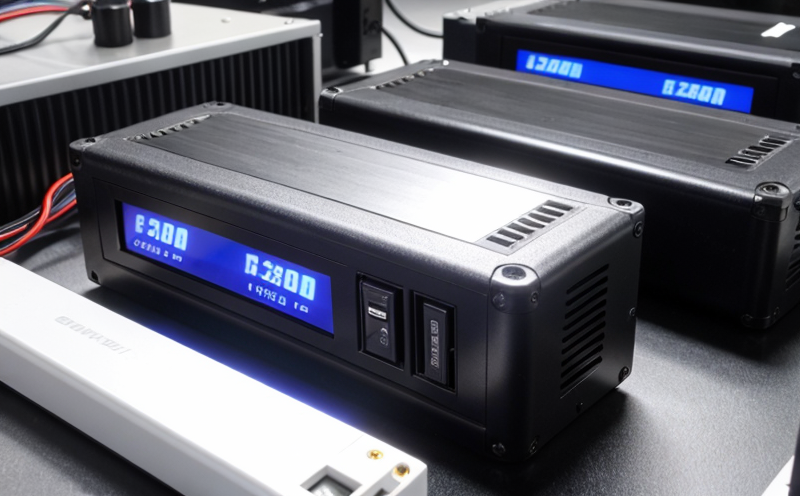ASTM F3149 Performance Testing of Lithium-Ion Cells Under Cycling Conditions
The ASTM F3149 standard provides a comprehensive framework for evaluating the performance characteristics of lithium-ion cells under cycling conditions. This test is critical in ensuring that battery cells meet stringent quality and safety standards, which are essential for various applications ranging from electric vehicles (EVs) to portable electronics.
Lithium-ion batteries have become ubiquitous due to their high energy density and long cycle life. However, the performance of these cells can vary significantly depending on manufacturing processes, materials used, and environmental conditions during use. ASTM F3149 testing helps manufacturers identify potential weaknesses in battery design and production methods early on, thereby improving product reliability.
The test involves subjecting lithium-ion cells to repeated charge-discharge cycles over a specified period or until certain failure criteria are met. During this process, various parameters such as voltage profiles, internal resistance, capacity retention, and specific energy are monitored closely. By following the guidelines set forth in ASTM F3149, laboratories can provide accurate assessments of cell performance that align with industry best practices.
One key aspect of ASTM F3149 is its focus on real-world use cases. For instance, EV manufacturers may need to simulate the battery's behavior under different driving conditions—ranging from urban stop-and-go traffic to highway cruising—to ensure it performs optimally across all scenarios. Similarly, consumer electronics firms might want to verify how well their products hold charge over extended periods without degradation.
Another important feature of this testing method is its emphasis on sustainability considerations. As environmental awareness grows, there's increasing pressure for companies to adopt eco-friendly practices throughout their supply chains. By incorporating ASTM F3149 into their quality assurance protocols, businesses can demonstrate commitment to reducing waste and resource consumption while maintaining top-notch product performance.
- Environmental Impact: Testing helps minimize overproduction by identifying substandard products early in the manufacturing process.
- Resource Efficiency: Properly designed batteries reduce landfill contributions due to extended lifespans and fewer replacements needed.
- Economic Benefits: Early detection of issues reduces costs associated with recalls and customer dissatisfaction.
Why Choose This Test
Selecting ASTM F3149 performance testing for lithium-ion cells offers numerous advantages. Firstly, it ensures compliance with international standards, which is crucial when operating within global markets or collaborating internationally.
Secondly, this test provides detailed insights into the durability and efficiency of battery cells under realistic conditions. This information is invaluable for research and development teams who aim to innovate without compromising safety or reliability.
In addition to these benefits, ASTM F3149 testing supports continuous improvement efforts by highlighting areas where improvements can be made. Whether it's refining electrode materials, optimizing electrolyte compositions, enhancing separator performance, or improving cell assembly techniques, this standardized approach fosters innovation across the entire industry chain.
Finally, choosing ASTM F3149 ensures consistent quality standards among suppliers and partners globally. This consistency is particularly important for OEMs (Original Equipment Manufacturers) who rely on reliable battery components to meet their demanding specifications.
Customer Impact and Satisfaction
Implementing ASTM F3149 performance testing has several positive impacts on customers. One significant benefit is increased trust in the products being offered, which translates directly into higher customer satisfaction levels.
By demonstrating adherence to rigorous testing protocols like ASTM F3149, companies can build stronger relationships with their clients by showing dedication to delivering high-quality solutions. This transparency also enhances brand reputation and fosters long-term partnerships between suppliers and customers alike.
Another positive outcome of adopting ASTM F3149 is reduced risk exposure for both parties involved. With thorough testing in place, there's less likelihood of encountering unexpected failures or recalls post-launch. Such incidents not only damage reputations but also incur additional expenses related to repairs, replacements, and potential legal actions.
Furthermore, customers who purchase products that have undergone ASTM F3149 performance testing benefit from extended warranties due to the enhanced confidence in product longevity and reliability. This assurance encourages more informed purchasing decisions while promoting loyalty among existing clients.
Environmental and Sustainability Contributions
- Reduction in Waste: Identifying faulty cells early through rigorous testing helps prevent wasteful disposal later on, contributing positively to landfill reduction efforts.
- Resource Conservation: By optimizing battery design based on test results, resources such as raw materials are used more efficiently throughout the lifecycle of a product.
- Emission Reduction: Enhanced durability and efficiency led by ASTM F3149 contribute to lower emissions from vehicles and devices powered by these batteries, supporting global climate goals.





